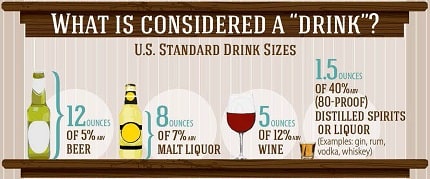How Much Beer Does It Take to Make a Baby Drunk
Alcohol
Not drinking alcohol is the safest option for breastfeeding mothers. Nonetheless, moderate alcohol consumption (up to 1 drink/day) is not known to be harmful to the infant.
What is "moderate consumption"?
The Dietary Guidelines for Americans defines moderate consumption for women of legal drinking age as up to 1 standard potable per day.
What is a "drink"?
The Dietary Guidelines for Americansexternal icon defines a standard "drinkable" as 12 ounces of v% beer; 8 ounces of 7% malt liquor; 5 ounces of 12% vino; or 1.five ounces of 40% (80 proof) liquor. All of these drinks contain the aforementioned amount (i.eastward., 14 grams, or 0.six ounces) of pure alcohol. All the same, many common drinks contain much more alcohol than this. For example, 12 ounces of 9% beer contains nearly the same amount of alcohol as ii (one.8) standard drinks. Consuming one of these drinks would be the equivalent of two standard drinks.

Is it safe for mothers to breastfeed their infant if they have consumed alcohol?
Not drinking alcohol is the safest choice for breastfeeding mothers. More often than not, moderate alcohol consumption past a breastfeeding mother (up to 1 standard drinkable per twenty-four hours) is not known to be harmful to the infant, especially if the mother waits at least 2 hours afterward a unmarried potable before nursing. However, exposure to booze above moderate levels through breast milk could be damaging to an babe'south development, growth, and slumber patterns. Alcohol consumption in a higher place moderate levels may besides impair a mother's judgment and ability to safely care for her child.
Drinking alcoholic beverages is not an indication to cease breastfeeding; withal, consuming more one drink per day is not recommended.
Can alcohol be establish in breast milk?
Yep. Alcohol levels are normally highest in breast milk 30-sixty minutes after an alcoholic beverage is consumed, and can be by and large detected in breast milk for well-nigh 2-3 hours per drinkable after it is consumed. Nevertheless, the length of time alcohol can be detected in breast milk will increase the more than booze a female parent consumes. For example, booze from one beverage can be detected in breast milk for well-nigh 2-3 hours, alcohol from 2 drinks can be detected for about four-5 hours, and booze from iii drinks can be detected for about 6-8 hours, and then on. However, blood alcohol levels and the length of time alcohol can be detected in breast milk later on drinking will depend on a number of factors, including the amount of alcohol consumed, how fast the alcohol is consumed, whether it is consumed with nutrient, how much a mother weighs, and how fast booze is broken downward in a mother'south trunk.
What effect does alcohol accept on a breastfeeding infant?
Moderate alcohol consumption by a breastfeeding mother (up to 1 standard drink per day) is not known to be harmful to the infant, especially if the mother waits at least 2 hours before nursing. All the same, college levels of alcohol consumption can interfere with the milk ejection reflex (letdown) while maternal alcohol levels are high. Over time, excessive alcohol consumption could lead to shortened breastfeeding duration due to decreased milk production. Excessive alcohol consumption while breastfeeding could besides impact the babe'south slumber patterns and early on development.
Alcohol and Caregivers
Caring for an infant while intoxicated is non rubber. Drinking alcohol could impair a caregiver'south judgement and his or her ability to safely intendance for an baby. If a caregiver drinks excessively, he or she should arrange for a sober adult to care for the infant during this time.
Tin can expressing/pumping chest milk subsequently consuming booze reduce the alcohol in the mother's milk?
No. The alcohol level in breast milk is essentially the same as the alcohol level in a female parent's bloodstream. Expressing or pumping milk after drinking booze, and and then discarding it ("pumping and dumping"), does NOT reduce the amount of alcohol present in the female parent'southward milk more quickly. Every bit the mother's booze claret level falls over time, the level of booze in her chest milk will likewise subtract. A mother may choose to express or pump milk later on consuming alcohol to ease her physical discomfort or attach to her milk expression schedule. If a mother decides to express or pump milk inside ii hours (per potable) of consuming alcohol, the female parent may choose to discard the expressed milk. If a female parent has consumed more a moderate amount of alcohol, she may choose to wait ii hours (per drink) to breastfeed her kid, or feed her infant with milk that had been previously expressed when she had non been drinking, to reduce her babe'south exposure to alcohol. Breast milk continues to comprise booze as long equally alcohol is withal in the female parent'due south bloodstream.
Source: https://www.cdc.gov/breastfeeding/breastfeeding-special-circumstances/vaccinations-medications-drugs/alcohol.html
0 Response to "How Much Beer Does It Take to Make a Baby Drunk"
Enregistrer un commentaire